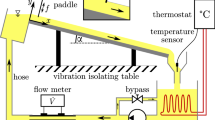Abstract
We consider Saffman–Taylor channel flow without surface tension on a high-pressure driven interface, but modify the usual infinite-fluid in infinite-channel configuration. Here we include the treatment of efflux by considering a finite connected body of fluid in an arbitrarily long channel, with its second free interface the efflux of this configuration. We show that there is a uniquely determined translating solution for the driven interface, which is exactly the 1/2 width S–T solution, following from correct symmetry for a finite channel flow. We establish that there exist no perturbations about this solution corresponding to a finger propagating with any other width: Selection is locally unique and isolated. The stability of this solution is anomalous, in that all freely impressible perturbations are stabilities, while unstable modes request power proportional to their strength from the external agencies that drive the flow, and so, in principle, are experimentally controllable. This is very different from the behavior of the usual infinite fluid. We conjecture that surface tension on the efflux interface modifies channel-width λ according to 1−2λ=σ/v (i.e., (2π)2 B of the literature) with v the velocity of the high-pressure tip, but σ the surface tension of the efflux. That is, λ is decreased below 1/2 by the effect of smoothing the distant efflux. The perturbation theory created here to deal with transport between two free boundaries is novel and dependent upon a symmetry implied by the equations of motion.
Similar content being viewed by others
REFERENCES
M. J. Feigenbaum, I. Procaccia, and B. Davidovich, J. Stat. Phys. 103:973(2001).
P. G. Saffman and G. I. Taylor, Proc. Roy. Soc. London Ser. A 245:312(1958).
P. Tabeling, G. Zocchi, and A. Libchaber, J. Fluid Mech. 177:67(1987).
B. I. Shraiman, Phys. Rev. Lett. 56:2028(1986).
D. C. Hong and J. S. Langer, Phys. Rev. Lett. 56:2032(1986).
R. Combescot, T. Dombre, V. Hakim, Y. Pomeau, and A. Pumir, Phys. Rev. Lett. 56:2036(1986)
S. Tanveer, Phys. Fluids 30:1589 (1987).
P. Pelce, ed., Dynamics of Curved Fronts (Academic, Boston, 1988) and references therein.
P. Ya. Polubarinova-Kochina, Dokl. Akad. Nauk SSSR 47:254(1945).
L. A. Galin, Dokl. Akad. Nauk SSSR 47:246(1945).
S. Ponce Dawson and M. Mineev-Weinstein, Phys. D 73:373(1994).
B. Shraiman and D. Bensimon, Phys. Rev. A 30:2840(1984).
S. Tanveer, Philos. Trans. Roy. Soc. London Ser. A 343:155(1993).
S. D. Howison, J. Fluid Mech. 167:439(1986).
Author information
Authors and Affiliations
Rights and permissions
About this article
Cite this article
Feigenbaum, M.J. Pattern Selection: Determined by Symmetry and Modifiable by Distant Effects. Journal of Statistical Physics 112, 219–275 (2003). https://doi.org/10.1023/A:1023683721747
Issue Date:
DOI: https://doi.org/10.1023/A:1023683721747




